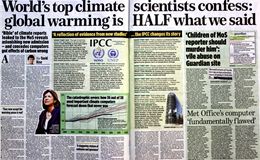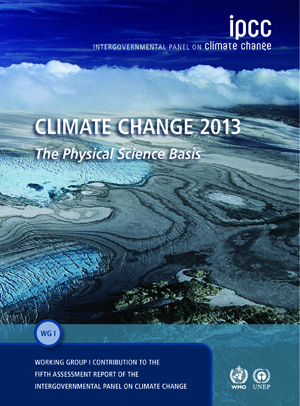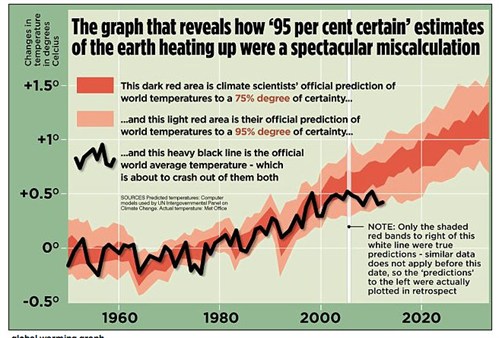September 2013:
Another inaccurate Mail on Sunday article on the upcoming IPCC report and climate science
In the run-up to the publication of the upcoming 5th assessment report of the IPCC there is a usual flurry of activity amongst those who have an interest in discrediting the substantial body of evidence pointing to the influence of human activity upon current and future climate change. The Mail on Sunday have published a series of inaccurate articles, including another by David Rose (15th September 2013).

The main claim by the recent Mail on Sunday article is that the rate of global warming since 1951 has been halved since the last IPCC report. This is completely incorrect. As clearly stated in the last IPCC report in 2007, the rate of warming since 1951 was not 0.2oC per decade (as stated by Rose) but 0.13oC per decade.
The 0.2oC per decade observed rate of surface warming applies to 1990-2005 which clearly cannot be compared with the period since 1951 and will not have changed since the last IPCC report. To confuse matters further the Mail tried to infer just this in a "correction" to their article on the 17th September by comparing the 1990-2005 period with 1997-2012, mixing up climate change and natural variability from one decade to the next.
Feeding off the Mail article the Telegraph proclaims "Top climate scientists admit global warming forecasts were wrong" elaborating upon this by saying "...the world is warming at a rate of 0.12C per decade since 1951, compared to a prediction of 0.13C per decade in their last assessment published in 2007." That's just 0.01oC per decade different and makes the title seem completely ridiculous. This is an embarrassment to the serious reporting of climate change elsewhere including writers from these same newspapers including Sam Webb (Mail) and Geoffrey Lean (Telegraph). A weak editorial in the Mail on Sunday further uses the Rose article to reaffirm its apparent agenda against wind farms and in favour of fracking.
Further claims by the Rose article include:
- "large parts of the world were as warm as they are now for decades at a time between 950 and 1250 AD." This may indeed apply to particular regions and seasons but the evidence indicates that warming in the late 20th century was far more coherent and strongly related to rising greenhouse gas concentrations.
- Antarctic sea ice "has actually grown to a new record high" rather than decreasing as predicted by simulations. While this is true when looking at the satellite record since 1979, the increases in Antarctic sea ice are smaller than the rapid decline in Arctic sea ice and are accompanied by a loss in Antarctic land ice. While the changes in Antarctic sea ice are not fully understood, changes in wind patterns relating to natural variability and human factors combined are likely to explain this variability.
- Evidence pointing to an intensification in Hurricanes (or tropical cyclones) has "simply been dropped, without mention" from the latest IPCC report. Considering the improved observations now used, there is certainly not strong evidence that human factors have altered the intensity of tropical cyclones. But climate simulations indicate that by the end of this century the most fierce tropical cyclones will become more intense, in particular the associated rainfall, the increases in which are based upon robust physics included in sophisticated climate simulations.

- The discussion about 90% or 95% confidence that over half of the warming since 1951 is caused by human activities does not seem warranted. While natural fluctuations in the ocean can and do influence decadal rates of surface warming, a large component of the warming since 1951 cannot be explained without including human factors such as burning of fossil fuels.
- The fact that "governments have tabled 1,800 questions and are demanding major revisions" to the IPCC summary for policy makers is overstated and a normal part of the process.
- The Met Office model has an unusually high equilibrium climate sensitivity (the amount of warming far in the future in response to a doubling of CO2 concentrations). While HadGEM2-ES does occupy the upper end of the range in climate model simulations, it cannot be discounted. A low climate sensitivity requires the observed strongly amplifying effects (termed positive feedbacks) of water vapour and surface ice to be counteracted by an equally strong negative feedback. There is no observational evidence for this and it is not yet known whether tropical low altitude clouds will amplify or diminish the warming response to greenhouse gas increases. However, the Met Office model is in fact generally regarded to provide one of the more realistic simulations of these cloud feedbacks and is built upon sound physical processes .
- Rose has suffered "extraordinarily vitriolic attacks from climate commentators". This is not acceptable, nor is abuse sent to climate scientists such as Michael Mann which is often much worse, nor is tax payers money wasted in addressing spurious claims by some parts of the media on the science of climate change.

- The IPCC "are scaling down their estimate" of the lowest range of climate sensitivity. Some new studies have indeed added to our knowledge of how climate will respond to rising greenhouse gases. However, arguing over a few tenths of a oC in climate sensitivity at the bottom of the range masks the real issue which is the expected substantial climate change in response to the continued emissions of greenhouse gases, which are at present following the worst case emissions scenarios.
The climate is highly complex and there will always be debate over what is causing each lump and bump in the temperature record. The recent slowdown in global surface warming is an example of this and the science has responded by moving forward. The latest IPCC report is our best assessment of the science of climate change but certainly cannot be considered perfect. Yet it looks set to build upon the evidence presented in the 2007 report by demonstrating a clear influence of recent warming of climate by human activity which looks set to increase in the near future.
March 2013:
Comments on a misleading Mail on Sunday article on global warming
A recent story in the Mail on Sunday by David Rose attempts to mislead the public by claiming that "...man-made global warming is a myth...". When all the evidence is considered, this statement is false. As discussed by Real Climate, some aspects of climate are changing more quickly than predicted by climate simulations (e.g. Arctic ice) and others are slower than the projections (e.g. surface temperature over the last 15 years) but observational evidence is consistent with continued man-made global warming.

The article confuses variability and climate change, mixes up processes occurring over millions of years and hundreds of years and ignores the bulk of research on current climate variability and change.
The story does not use a graph from a leaked IPCC report as claimed but instead from the popular and thought-provoking blog by Ed Hawkins, ClimateLabBook, without permission (an acknowledgement has since been placed in the online version of the article) and incorrectly describing some of its details. It shows how rapid warming of climate since the 1970s has slowed over the last 15 years and that warming is below the rate simulated by the vast majority of climate models. This is interesting and is actively being researched, for example in a new National Environment Research Council project, "DEEP-C" which involves the University of Reading, the National Oceanography Centre in Southampton and the Met Office.

Current research, using observations, indicates that heat is continuing to accumulate in the oceans since 2000, consistent with the build-up in greenhouse gases. Global warming has not stopped as the oceans are continuing to heat up. However, in the recent decade, the warming is occurring beneath the ocean surface, suggesting that the current slowing in the rate of surface warming is due to natural ocean variability (although other factors including changes in the solar output, small volcanic eruptions, anthropogenic aerosol emission from Asia and changes in stratospheric water vapour may also have contributed by offsetting some of the radiative forcing from the steadily increasing greenhouse gas concentrations).
An illustration of the effect of variability on global warming appears in another blog by Ed Hawkins. Climate model simulations do produce decades of flat surface temperature in response to anthropogenic global warming. This is down to natural variability (sometimes the build-up of heat is buried further down in the ocean). The graph used in the Mail article averages over lots of models. While some models have higher rates of warming, others display little warming in each decade, because of natural variability; averaging smooths this variability out. This is primarily what gives the spread in surface temperature changes over the last few decades.
The article misrepresented scientists who were consulted (for example, see the comments by Myles Allen) and also contains many other inaccuracies.
For example, the article states: "The evidence shows CO2 levels follow temperature, not the other way around...". This is true over many hundreds to thousands of years, during glacial cycles (changes from glacial ice-age periods to milder interglacial periods like today) which is well known and understood. Atmospheric CO2 and methane changes naturally amplify these glacial cycles. Presently, however, we are generating CO2 from fossil sources, accumulated over millions of years but burnt and emitted back into the atmosphere by human activity over a few hundred years. The build-up of greenhouse gases in the atmosphere over the last hundred years is causing heat to accumulate in the climate system, primarily the oceans. This is why humans are now responsible for global warming of the planet.
Also stated is "...the world can live with these fluctuations in the level of atmospheric carbon...". Since the time in which anatomically modern humans evolved (around 200,000 years ago) CO2 has been below 300 parts per million, until today. CO2 has not been at 4,000 parts per million, as quoted in the article, since 180 million years ago when continents and life on Earth were vastly different to today.
The article also states: "But the scientists behind the theory have a vested interest - its a great way to justify new taxes, get more money and guarantee themselves more work...". Scientists generally choose to study their subject because they are fascinated by it (I have been intrigued by climate change since the age of 10) and not because they want to make lots of money. In the article, the author notes: "I rapidly found myself cast out from the BBC..." and devotes some lines to this. Is this relevant to the article or a personal issue?
The myth that in the 1970s an ice age was predicted is recapitulated in the article. This was not the scientific consensus at the time and primarily reflects media stories (e.g. Time magazine). This and many other myths are examined by Skeptical Science.
A previous article by David Rose appeared in the Mail earlier this year and the expert reaction was similarly damning. Recent blogs and articles, for example by Bad Astronomy, The Carbon Brief, Myles Allen and Skeptical Science, also offer an opinion on the recent Mail story.
Observed changes in climate are in fact consistent with heating of climate due to greenhouse gas emission from human activity which has been offset by additional emissions of pollutant particles called aerosols. The magnitude of future climate change is not certain but the likelihood of damaging climate change appears very likely based upon multiple lines of evidence including basic physics, a multitude of observations and a vast array of detailed physics-based global simulations and experiments.
Richard P. Allan Location: Department of Meteorology (2U15)